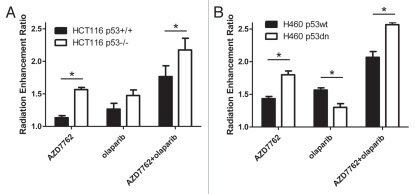Figure 3.
Preferential radiosensitization by AZD7762 and olaparib in p53-defective cancer cells. HCT116 (A) and H460 (B) p53 isogenic cell lines were treated with AZD7762 and olaparib. Clonogenic survival plating efficiencies were 0.4 ± 0.1 (HCT116 p53+/+), 0.5 ± 0.03 (HCT116 p53−/−), 0.7 ± 0.03 (H460 p53wt) and 0.5 ± 0.2 (H460 p53 dn). The mean radiation enhancement ratios ± SE are shown for n = 3–4 independent experiments (See Figs. S2 and 4, respectively for representative clonogenic survival curves). Statistically significant differences between p53+/+ and p53−/− (HCT116) or p53 wt and p53 dn (H460) are indicated (*p < 0.05). Other significant differences not illustrated for both the HCT116 and H460 cell lines include control vs. AZD7762 (except HCT116 p53+/+), olaparib (except HCT116 p53+/+) or AZD7762 + olaparib as well as AZD7762 or olaparib alone vs. AZD7762 + olaparib.

